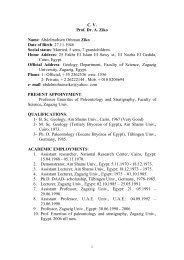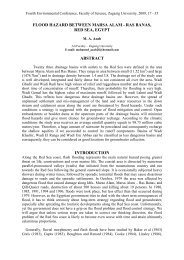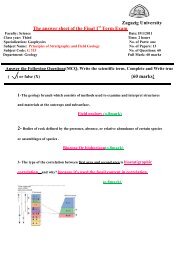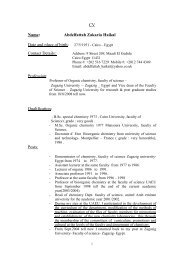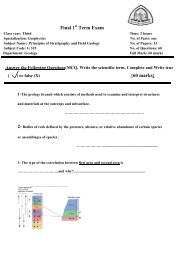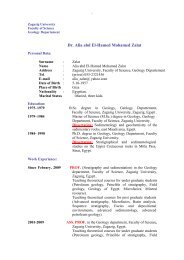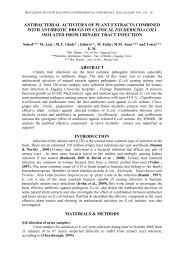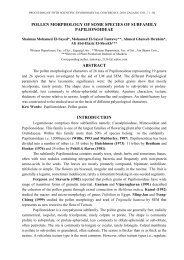118PREVALENCE OF TOXIGENIC BACTERIA IN SOME EGYPTIAN FOOD(Soriano et al., 2002). Twenty different types <strong>of</strong> SEs, viz., SEA through SEE, SEG throughSER and SEU have already been discovered, however, only a few <strong>of</strong> the tox<strong>in</strong> serotypes arefrequently associated with <strong>food</strong> poison<strong>in</strong>g outbreaks (Mart<strong>in</strong> et al., 2004; Smyth et al., 2005and Fernández et al., 2006).M 1 2 3 4695bp565bpPhoto(3): Agarose gel show<strong>in</strong>g the PCR amplicons result<strong>in</strong>g from amplification <strong>of</strong> enterotox<strong>in</strong>s genes hblCand cytK us<strong>in</strong>g FHblC & RHblC and FCytk & R2Cytk primers. Lane M is 100bp DNA ladder marker;lanes 1,2,3&4 DNA amplicons <strong>of</strong> B. cereus G8,LB3 ,GT13&CH respectively. The gel reveals presence <strong>of</strong>both enterotox<strong>in</strong> genes (hblC &cytK) <strong>in</strong> stra<strong>in</strong>sGT1, LB3 & G8.Multiplex PCR technique has been recently used for rapid detection anddiscrim<strong>in</strong>ation <strong>of</strong> enterotox<strong>in</strong>s genes <strong>in</strong> B. cereus (Gu<strong>in</strong>ebretiere et al., 2006 andNagmwongsatit et al., 2008); and for direct detection <strong>of</strong> <strong>food</strong> contam<strong>in</strong>ation withentero<strong>toxigenic</strong> B. cereus as well (Ombui et al. 2008).Ngmwongsatit et al. (2008) have developed and evaluated group <strong>of</strong> new primerswhich were highly efficient <strong>in</strong> detect<strong>in</strong>g the tox<strong>in</strong> genes <strong>in</strong> 100% <strong>of</strong> their tested B. cereus andB. thur<strong>in</strong>gensis stra<strong>in</strong>s. Thus, it could be expected that the presence <strong>of</strong> either genes is an<strong>in</strong>dication for the presence <strong>of</strong> the whole operon.In this study the primers designed by Ngmwongsatit et al. (2008) were used underspecific multiplex PCR conditions, previously mentioned <strong>in</strong> materials and methods, to detectpresence <strong>of</strong> the enterotox<strong>in</strong> genes (hblC &cytK) <strong>in</strong> tested stra<strong>in</strong>s. Photo (3) revealed presence<strong>of</strong> amplified DNA fragments <strong>of</strong> the two tox<strong>in</strong> genes <strong>in</strong> three stra<strong>in</strong>s <strong>of</strong> B. cereus (CH, GT1 &G8) <strong>in</strong> one quick step. The tox<strong>in</strong> genes hblC & cytK predicted molecular sizes <strong>of</strong> 695 & 565bp, respectively.
Nadia Mohamed Awny; Azza A. M. Abou Zeid and Mohamed Ahmed Abdo 119478bp(seb)317bp(sed)244bp(sec)170bp(see)127bp(sea)Photo(4): Agarose gel show<strong>in</strong>g the PCR amplicons result<strong>in</strong>g from amplification <strong>of</strong> enterotox<strong>in</strong>s genes sea,seb, sec-1, sed and see us<strong>in</strong>g their specific primers. Lane M is 100bp DNA ladder marker; lanes 1,2,3&4DNA amplicons <strong>of</strong> S. aureus S,S1,S2&S3 respectively. The gel reveals presence <strong>of</strong> enterotox<strong>in</strong>s sea & sed<strong>in</strong> S. aureus S1 and sed <strong>in</strong> S. aureus S3.Regard<strong>in</strong>g the enterotox<strong>in</strong> genotype, previous studies on S. aureus proved that enterotox<strong>in</strong>PCR determ<strong>in</strong>ations are <strong>in</strong> a high agreement (97–100%) with the tox<strong>in</strong> production as def<strong>in</strong>ed byimmunoassays (Fueyo et al., 2001, Letertre et al., 2003 and McLauchl<strong>in</strong> et al., 2000).Enterotox<strong>in</strong> genotyp<strong>in</strong>g <strong>of</strong> tested stra<strong>in</strong>s revealed presence <strong>of</strong> sed gene <strong>in</strong> both stra<strong>in</strong>s S.aureus (S1 & S3) and sea gene <strong>in</strong> stra<strong>in</strong> (S1) only.P<strong>in</strong>to et al. (2005) found a total <strong>of</strong> 40 (30%) S. aureus <strong>food</strong> isolates positive for se genes.Among them, the sec genotype was the most frequent (22 stra<strong>in</strong>s,20% <strong>of</strong> total se positive stra<strong>in</strong>s) andsea the second more frequent (14 stra<strong>in</strong>s, 13%),which is <strong>in</strong> accordance with the results obta<strong>in</strong>ed by(Fueyo et al., 2001 ). Data on enterotox<strong>in</strong> genotype confirmed the group<strong>in</strong>g <strong>of</strong> stra<strong>in</strong>s nuc PCRpositive and se PCR positive <strong>in</strong> S. aureus clusters.On the basis <strong>of</strong> these results, we suggest amplification <strong>of</strong> enterotox<strong>in</strong> genes as targetgenes us<strong>in</strong>g multiplex PCR test as a rapid and valuable technique that can be applied directlyto s<strong>in</strong>gle colonies grow<strong>in</strong>g on selective plates for a rapid, accurate and unequivocalidentification <strong>of</strong> B. cereus and S. aureus. It could be implemented as an alternative tophenotypic and immunology-based tests <strong>in</strong> the rout<strong>in</strong>e <strong>food</strong> microbiological analysis.REFERENCESAgata, N.; Ohta, M. and Yokoyama, K. (2002). Production <strong>of</strong> Bacillus cereus emetic tox<strong>in</strong>(cerulide) <strong>in</strong> various <strong>food</strong>s. Int. J. Food Microbiol., 73: 23-27.APHA, (1992). Compendium <strong>of</strong> methods for the microbiological exam<strong>in</strong>ation ,3rd Edn.,Wash<strong>in</strong>gton, American Public Health Association.Balaban, N. and Rasooly, A. (2000). Staphylococcal enterotox<strong>in</strong>s, Int. J. Food Microbiol. 61: 1–10.Becker, K., R. Roth, and G. Peters. (1998). Rapid and specific detection <strong>of</strong> <strong>toxigenic</strong>Staphylococcus aureus: use <strong>of</strong> two multiplex PCR enzyme immunoassays for



